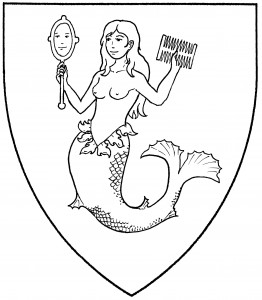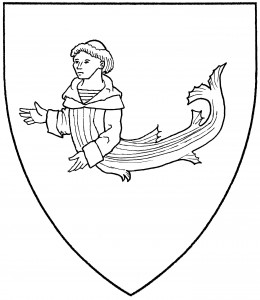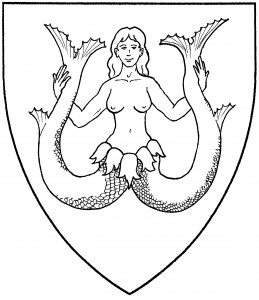The mermaid is a sea–monster, with the body of a maiden conjoined to a fish’s tail; it was also termed a “siren”. It is usually depicted with a mirror and comb, which position may be blazoned “a mermaid in its vanity”. The mermaid is found as a supporter in the early 14th Century [Dennys 123]; as a charge on a shield, it’s used in the arms of Ornelas, c.1540 [Nobreza xxiiiº].
It can also be male, of course; the male form may be blazoned a “merman” or a “triton”. It too is found in period grants, dating from at least 1483 as a supporter of Wydville, Earl Rivers [Dennys 129]; it’s also found as a supporter of the Worshipful Company of Fishmongers, 1575 [Bromley & Child 91]. The merman is frequently armored, in some cases with his entire human half covered in plate. Both mermaid and merman are affronty by default; period heraldic art turns the figure ever so slightly to dexter, in an early attempt at perspective.
One specific form of merman is blazoned a “monk-fish”, with the human portion vested in monk’s robes. The form shown here is taken from Meidenbach’s Hortus Sanitatis, an herbal/natural history dated 1491. As an heraldic charge, the monk-fish appears to be unique to the Society.
A Continental version of the mermaid is the “melusine”, which has two fish’s tails replacing the maiden’s legs, instead of a single fish’s tail; it is a period charge, found in the arms of Östermayr, 1605 [Siebmacher 36]. The melusine’s default posture is affronty, holding one tail in each hand. Unlike the mermaid, the melusine is sometimes shown in period emblazons with its human half vested.
When blazoned “proper”, merfolk are tinctured with Caucasian (pink) human parts, and green fish’s tails; the hair color is usually explicitly blazoned, but blonde seems most common. See also silkie.
The College of Saint Giles bears as a badge: A monk-fish naiant to sinister argent.
Ane-Marie Varre of Helsingor bears: Azure, a mermaid and a merman affronty proper, their adjacent arms elevated and crossed.
Rollo Melles bears: Gules, a melusine argent.


